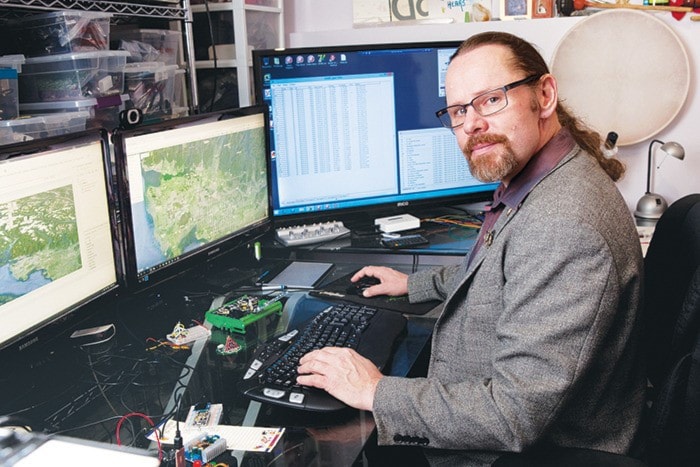Jeff NagelBlack Press
The mild earthquake that shook Vancouver Island and the Lower Mainland Dec. 29 provided a real world test of an early warning system developed by UBC researchers that could help B.C. residents survive a deadly quake.
Thirteen seconds before buildings began to shake at 11:40 p.m. Dec. 29, research engineer Kent Johansen already knew what was coming and that their system works.
“It worked like a charm,” he said.
Johansen was working late in his home office in Burnaby when the alert came in from the network of quake sensors that have been installed mainly at Catholic schools and a few public ones in the Lower Mainland, Nanaimo and Victoria.
His computer emitted a rumbling noise pre-programmed to indicate elevated shaking was imminent.
“I looked at the screen and I see the bar graph go right through the roof – 10 times more than I’ve ever seen in the year and a quarter that we’ve been running,” he said. “I thought ‘Holy smokes that’s a real one.’”
Johansen resisted the temptation to wait for the seismic data flow in and instead bounded upstairs to his wife and seven-year-old daughter. He had enough time to get them both under a table before the shaking started.
If a much bigger earthquake someday strikes, the system would sound sirens at schools – it’s active at 61 of them already – and offer a critical 10 to 30 seconds of advance warning for teachers to get students under their desks for protection.
Signs would also be activated warning drivers not to enter vulnerable bridges and tunnels.
A similar quake warning system is already installed at the George Massey Tunnel, complete with ‘Do not enter’ digital signs. They’ve never been triggered – the recent 4.7 magnitude quake wasn’t large enough.
TransLink is also studying the feasibility of adding a warning system to close the Pattullo Bridge in the event of a quake or dangerous high winds.
More schools, including several in the Fraser Valley, are being outfitted with the technology and are expected to come online soon, joining the initial 61 sites that have received the UBC technology since 2013.
Johansen hopes to extend the same warning system to anyone via apps on smart phones and other alert methods. He’s already experimenting with a text message system and automated Twitter account (@EEW_BC) to beam out alerts, though he stresses he doesn’t know how much warning time is lost in transmission and reception.
Even a few seconds warning could allow surgeons to put down scalpels and lab techs to turn off gas burners.
Johansen also thinks of workers in warehouses and shoppers in big box stores where products are piled high on the walls above them who might get time to step away from the danger.
Ground motion sensors that consist of small accelerometers are buried underground at each detector site.
They detect a quake’s primary waves (P waves) that usually cause no damage and arrive twice as fast as the slower shear waves (S waves) that break windows and cause walls to collapse.
The first sensors to detect a quake’s incoming P wave – and not other sources of vibration like heavy trucks – relay their data to UBC’s Earthquake Engineering Research Facility, which sends an alert throughout the network and sounds sirens at alarm sites. (Animals that act strangely just before a quake are also thought to be sensing the P waves.)
How much warning there will be before the shaking starts depends on how far away the quake’s epicentre is and the proximity of sensors to detect it.
The closest sensor to the Dec. 29 quake was in Victoria and Johansen figures an extra six seconds of warning would have been gained had a sensor been positioned closer to the epicentre, which was east of Sidney.
A massive subduction quake 100 kilometres off the west coast of Vancouver Island would offer the most time – potentially 60 to 90 seconds for Metro Vancouverites.
That type of monster quake could rip along the Cascadia subduction zone all the way from Haida Gwaii to Oregon.
For that reason, researchers would like to have sensors on B.C.’s north coast and even offshore, but there are military sensitivities because the devices can also detect passing submarines.
“There’s a cave off somewhere in the Haida Gwaii where they like to come up with submarines and hide in,” Johansen said. “The Americans are concerned about having data transmitted unfiltered from there. So that’s a problem. But even something on the west coast [of Vancouver Island] can give us lots of warning.”
He hopes to see a much broader network of sensors over time, as well as many more alarm sites.
“If I had my way they’d be in all schools and we’d add even more sensors,” Johansen said. “Two seconds here and two seconds there – it all saves lives. To me, if it can save one, we have to do it.”
